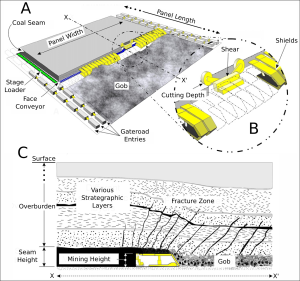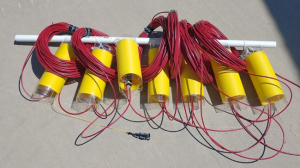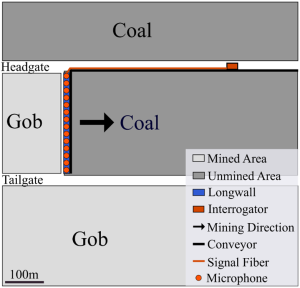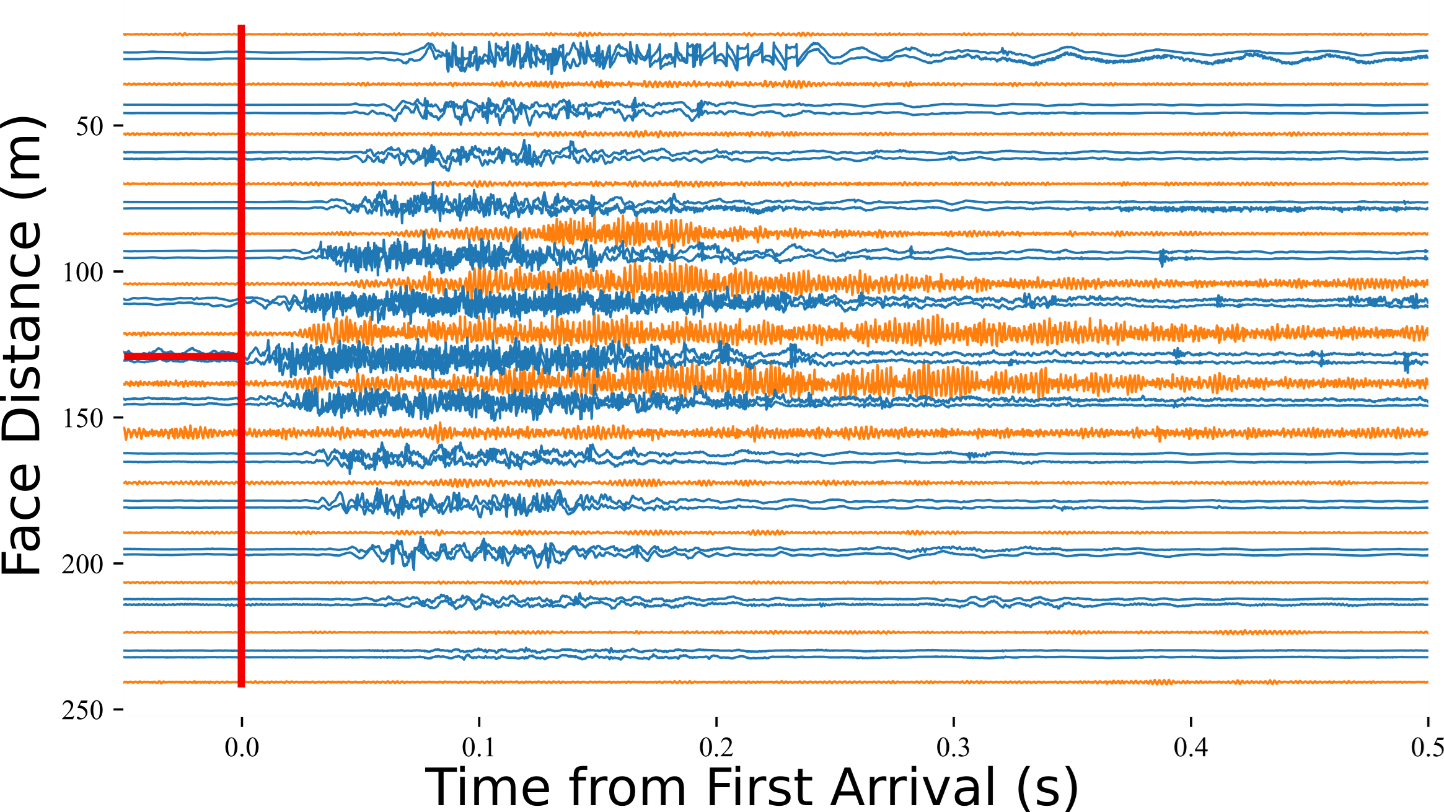The Sound of Rockbursts: A new monitoring approach for longwall coal mines
Posted on by
A rockburst is a phenomenon where rock or coal is violently ejected into mine openings. Rockbursts can release significant amounts of energy and have the potential to injure workers and disrupt operations. Despite decades of research, these events are notoriously difficult to predict, and focus has turned to managing the related risks.
In hardrock mines, seismic monitoring – the same technology used to monitor earthquakes, has proven invaluable for understanding and managing rockburst-related hazards. Most deep hardrock mines have a seismic monitoring system. However, coal mines, specifically longwall mines, have struggled to apply these same systems. There are several reasons for this [Swanson et al. 2016], including:
- Coal mines operate at much larger scales and advance faster than most hardrock mines;
- Use of electronics is heavily restricted due to the possible presence of explosive gasses; and
-

Figure 1. Longwall mining concept showing (A) an oblique view of the longwall operating, (B) a close up of the shearer, and (C) a profile view of the overburden. Image from NIOSH. Coal mines tend to produce many more seismic events than hardrock mines, which makes it difficult to process the data quickly enough to be meaningful.
To help overcome these challenges, researchers in NIOSH’s mining program have developed a new approach to monitor rockbursts occurring near the longwall face using fiber optic cable.
Longwall Mining
Longwall mining is the most productive form of underground coal mining. It is also employed for mining soft minerals like soda ash (e.g., in the form of trona) and pot ash. In this mining method, large panels of material (up to 0.25 miles wide by 2-5 miles long) are extracted using a cutting device that moves up and down the mining face. A long line of hydraulic shields holds up the immediate roof, and a conveyor system hauls the resource out of the mine. As material is extracted, the previously mined area is simply allowed to cave and fill the void created by mining. This industry video by F.T.I Pty Ltd* provides a visual introduction to the longwall mining method.
Distributed Acoustic Sensing Array

Distributed fiber optic sensing (DFOS) is a family of relatively new monitoring technologies that use laser pulses in a fiber optic cable to measure different quantities, such as strain or temperature along the fiber. A subset of DFOS is distributed acoustic sensing (DAS), which measures vibrations in the fiber optic cable and is capable of recording rockbursts and other mining-induced seismic events, meaning that it could be used in place of traditional seismic monitoring systems. One advantage of DAS, and DFOS in general, is that the fiber optic cable itself is used to make up a string of sensors that can be several miles long. This enables monitoring at scales that were previously impractical. Additionally, the electronics can be deployed miles away in fresh air while the cable itself can be installed anywhere, allowing for monitoring of areas previously off-limits due to concerns about explosions.
In order to adapt DAS for monitoring seismicity at a longwall face, NIOSH researchers created an array of fiber optic “microphones” that are just fiber optic cable wrapped around hollow plastic cylinders (see figure 2). The microphones are attached to the longwall shields by lead cables, which are loose segments of fiber optic cable. Both microphones and lead cables can be used as sensors. Because the monitoring array is physically attached to the mining equipment, it advances with the longwall face.

Proof of Concept Deployment
A test deployment was conducted at a longwall coal mine in the United States. The lead cables (red) were zip-tied to the shields and 14 microphones were deployed across the face (see figure 2).
During the deployment, several seismic events were detected by a surface seismic network. Examples of the audio recorded by the DAS microphones during these events are included below. In these recordings you can hear the hum of the longwall machinery followed by a crashing noise as material is ejected onto the face. While these events weren’t particularly hazardous, they do represent a smaller version of a rockburst. Because of the dense array (sensors every few feet), it is possible to estimate where the event occurs along the longwall face by identifying the sensor that detects the event first (red lines in Figure 4).

The lead cables (blue) tend to record shorter signals that are likely more representative of the released seismic energy while the microphones (orange) record longer signals on a few channels closest to the events, picking up the sounds of the material being ejected and settling.
Monitoring Implications
The DAS array overcomes many of the shortcomings of traditional in-mine seismic monitoring for coal mines:
- Sensors move with the mining front, eliminating need for frequent reconfigurations, and
- Since the sensing element is an intrinsically safe fiber optic cable, there are no restrictions on its placement.
Additionally, the array records near-field data (sounds and vibrations) that may provide better information about the extent and mechanisms of the damage caused by rockbursts than traditional seismic systems.
Although improvements are needed before DAS-based arrays can be routinely used for seismic monitoring, they provide a new kind of data that may help engineers better understand and manage rockburst risks in longwall mines. Other types of mines may also benefit from DAS and seismoacoustic monitoring. Please reach out to the NIOSH mining program (mining@cdc.gov) if you would like to further discuss fiber optic sensing research in underground mines.
Derrick Chambers, M.S., is a mining engineer in the NIOSH Spokane Mining Research Division.
Shawn Boltz, M.S., is a mining engineer in the NIOSH Spokane Mining Research Division.
*References to companies, products or services do not constitute an endorsement or favoritism by NIOSH, CDC, HHS, or the U.S. government.”
References
Chambers D, Shragge J [2023]. Seismoacoustic Monitoring of a Longwall Face Using Distributed Acoustic Sensing. Bulletin of the Seismological Society of America 2023 doi: https://doi.org/10.1785/0120220219
Karacan CÖ [2008]. Modeling and prediction of ventilation methane emissions of longwall mines using supervised artificial neural networks. International Journal of Coal Geology 73(3-4):371-387, 10.1016/j.coal.2007.09.003.
Swanson P, Boltz MS, Chambers D [2016]. Seismic monitoring strategies for deep longwall coal mines, ed. by NIOSH Spokane, WA: U.S. Department of Health and Human Services, Centers for Disease Control and Prevention, National Institute for Occupational Safety and Health, p. 100.
Posted on by

